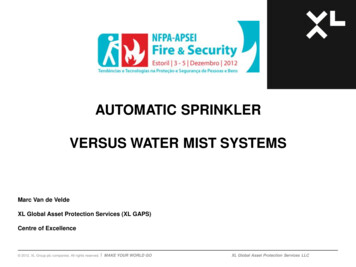![First Revision No. 5-NFPA 1003-2017 [ Global Input ] Supplemental .](/img/30/1003-f2018-pqu-ffq-fd-frstatements.jpg)
Transcription
First Revision No. 5-NFPA 1003-2017 [ Global Input ]The CC recommended to all pro-qual TCs to add a matrix and locate it as Annex C.This is a quick source guide based on JPRs and levels, positions, or chapters withthe main document. See attached file for new Annex C.Supplemental InformationFile NameDescription Approved1003-FR-5 Annex C.docxSubmitter Information VerificationSubmitter Full Name: Robert FashOrganization: National Fire Protection AssocStreet Address:City:State:Zip:Submittal Date: Wed Feb 01 15:09:39 EST 2017Committee StatementCommittee Statement: Committee created a reference guide annex for JPRs contained in the document.Response Message:Public Input No. 3-NFPA 1003-2016 [Global Input]First Revision No. 6-NFPA 1003-2017 [ Global Input ]NEW ANNEX D CHAPTER.Annex D National Fallen Firefighters Foundation (NFFF)This annex is not a part of the requirements of this NFPA document but is included forinformational purposes only.D.1 “16 Firefighter Life Safety Initiatives.”In 2004, the National Fallen Firefighters Foundation (NFFF) held an unprecedentedgathering of the fire service leadership when more than 200 individuals assembled inTampa, Florida, to focus on the troubling question of how to prevent line-of-duty deaths andinjuries. Every year approximately 100 fire fighters lose their lives in the line of duty in the
United States — about 1 every 80 hours. Every identifiable segment of the fire service wasrepresented and participated in the summit.The first Firefighter Life Safety Summit marked a significant milestone, because it not onlygathered all segments of the fire service behind a common goal, but it also developed the“16 Firefighter Life Safety Initiatives.” The summit attendees agreed that the “16 FirefighterLife Safety Initiatives” serve as a blueprint to reduce line-of-duty deaths and injuries. In2014, a second Life Safety Summit was held and more than 300 fire service leadersgathered. At the second Firefighter Life Safety Summit, the “16 Firefighter Life SafetyInitiatives” were reaffirmed as being relevant to reduce line-of-duty deaths and injuries.D.2 NFFF’s “16 Firefighter Life Safety Initiatives.”(1) Define and advocate the need for a cultural change within the fire servicerelating to safety, incorporating leadership, management, supervision,accountability, and personal responsibility.(2) Enhance the personal and organizational accountability for health and safetythroughout the fire service.(3) Focus greater attention on the integration of risk management with incidentmanagement at all levels, including strategic, tactical, and planning responsibilities.(4) All fire fighters must be empowered to stop unsafe practices.(1) Develop and implement national standards for training, qualifications, andcertification (including regular recertification) that are equally applicable to all firefighters based on the duties they are expected to perform.(2) Develop and implement national medical and physical fitness standards thatare equally applicable to all fire fighters, based on the duties they are expected toperform.(3) Create a national research agenda and data collection system that relates tothe initiatives.(4) Utilize available technology wherever it can produce higher levels of health andsafety.(1) Thoroughly investigate all fire fighter fatalities, injuries, and near misses.(2) Grant programs should support the implementation of safe practices and/ormandate safe practices as an eligibility requirement.(3) National standards for emergency response policies and procedures should bedeveloped and championed.(4) National protocols for response to violent incidents should be developed andchampioned.(1) Fire fighters and their families must have access to counseling andpsychological support.(2) Public education must receive more resources and be championed as a criticalfire and life safety program.(3) Advocacy must be strengthened for the enforcement of codes and theinstallation of home fire sprinklers.(4) Safety must be a primary consideration in the design of apparatus andequipment.Submitter Information Verification
Submitter Full Name: Robert FashOrganization: National Fire Protection AssocStreet Address:City:State:Zip:Submittal Date: Wed Feb 01 15:19:31 EST 2017Committee StatementCommittee Technical Committee has added Annex "D" to follow the direction by the Technical CorrelatingStatement: Committee on Professional Qualifications to have National Fallen Firefighters Foundation (NFFF)“16 Firefighter Life Safety Initiatives” identified as an annex of each professional qualificationstandard to emphasize the vision of reducing injuries and deaths of emergency service personnel.ResponseMessage:Public Input No. 6-NFPA 1003-2017 [Global Input]First Revision No. 1-NFPA 1003-2017 [ Section No. 2.2 ]2.2 NFPA Publications.National Fire Protection Association, 1 Batterymarch Park, Quincy, MA 02169-7471.NFPA 1001, Standard for Fire Fighter Professional Qualifications, 20132018 edition.NFPA 1500, Standard on Fire Department Occupational Safety, and HealthHealth, andWellness Program, 20132018 edition.Submitter Information VerificationSubmitter Full Name: Robert FashOrganization: National Fire Protection AssocStreet Address:City:State:Zip:Submittal Date: Wed Feb 01 14:47:09 EST 2017Committee StatementCommittee Statement: Extract updated to reflect most recent version of references.
Response Message:Public Input No. 7-NFPA 1003-2017 [Section No. 2.2]First Revision No. 2-NFPA 1003-2017 [ Section No. 2.4 ]2.4 References for Extracts in Mandatory Sections.NFPA 402, Guide for Aircraft Rescue and Fire-Fighting Operations, 20132018 edition.NFPA 403, Standard for Aircraft Rescue and Fire-Fighting Services at Airports, 20142018edition.NFPA 1000, Standard for Fire Service Professional Qualifications Accreditation andCertification Systems, 20112017 edition.NFPA 1001, Standard for Fire Fighter Professional Qualifications, 20132018 edition.NFPA 1002, Standard for Fire Apparatus Driver/Operator Professional Qualifications,20142017 edition.NFPA 1031, Standard for Professional Qualifications for Fire Inspector and Plan Examiner,2014 edition.Submitter Information VerificationSubmitter Full Name: Robert FashOrganization: National Fire Protection AssocStreet Address:City:State:Zip:Submittal Date: Wed Feb 01 14:48:32 EST 2017Committee StatementCommittee Statement: Extracts update to reflect most recent version of references used in the document.Response Message:Public Input No. 4-NFPA 1003-2017 [Section No. 2.4]Public Input No. 8-NFPA 1003-2017 [Chapter 3]First Revision No. 7-NFPA 1003-2017 [ Section No. 3.3.4 ]3.3.4 Critical Rescue and Fire-Fighting Access Area.
The rectangular area surrounding any runway within which most aircraft accidents can beexpected to occur on airports. Its width extends 500 ft (150 m) from each side of therunway centerline, and its length is 3300 ft (1000 m) beyond each runway end. [402,20132018]Submitter Information VerificationSubmitter Full Name: Robert FashOrganization: National Fire Protection AssocStreet Address:City:State:Zip:Submittal Date: Wed Feb 15 16:25:18 EST 2017Committee StatementCommittee Statement: Definition updated to the exact document definition.Response Message:Public Input No. 5-NFPA 1003-2017 [Section No. 3.3.4]First Revision No. 15-NFPA 1003-2017 [ Section No. 3.3.16]3.3.16* Theoretical Critical Fire Area (TCA).The theoretical critical fire area (TCA) is a rectangle, the longitudinal dimension of which isthe overall length of the aircraft, and the width includes the fuselage and extends beyond itby a predetermined set distance that is dependent on the overall width. Therefore, theaircraft length multiplied by the calculated width equals the size of the TCA. [402,20132018]Submitter Information VerificationSubmitter Full Name: Robert FashOrganization: National Fire Protection AssocStreet Address:City:State:Zip:Submittal Date: Wed Feb 15 16:33:46 EST 2017
Committee StatementCommittee Statement: Extract definition updated with edition year.Response Message:First Revision No. 17-NFPA 1003-2017 [ Section No.A.4.1.1.3 ]A.4.1.1.3Airport fire fightersFire Fighters should possess knowledge of military aircraft at thoseairports that accept military aircraft or at those airports that are co-located with a militaryinstallation with either separate or shared runways. This knowledge should include thefollowing:(1) Military cargo/passenger aircraft(2) Military tanker aircraft(3) Military fighter/attack aircraft(4) Military helicopter aircraftUSAF Technical Order 00-105E-9, Aerospace Emergency Rescue and Mishap ResponseInformation (Emergency Services), contains specific information concerning aircraft rescueand fire-fighting procedures and should be consulted prior to any attempt to performrescue operations if trained military specialists are not available for immediate assistance.USN/USMC aircraft information is located in NAVAIR 00-80R-14 and 00-80R-14-1. Thesedocuments contain specific information concerning fire-fighting and rescue operations foraircraft in the military inventory. They specifically address the following:(1) Entry. If the emergency controls are activated, an explosive charge willexplosively separate the canopy from the aircraft.(2) Ejection Systemssystems. All fighter, bomber, and attack aircraft areequipped with ejection seats. Once access has been gained to the cockpit,caution is extremely important, because these ejection seats, whenactivated, are propelled out of the aircraft by an explosive charge. Airportfire fightersFire Fighters should not touch or activate any controls. Note thatif a canopy or hatch has been separated from an aircraft, the ejection seat isautomatically armed. Extreme caution must be exercised in crew removal.(3) Extrication. The aircrew member is secured to the seat by a series of straps,harnesses, and restraint belts. These restraints can be released by cutting ifthe release procedure is unknown.(4) Ordnance. Fighter and attack aircraft will have forward firing ordnancelocated in the forward part of the fuselage or wings.(5) Engine Shutdownshutdown. Engine shutdown usually can be accomplishedby pulling T-handles, as on a commercial jet.
The NFPA Aircraft Familiarization Charts Manual, which contains complete diagrams of115 types of aircraft, detailing their physical characteristics, is also helpful.Submitter Information VerificationSubmitter Full Name: Robert FashOrganization: National Fire Protection AssocStreet Address:City:State:Zip:Submittal Date: Mon Feb 20 07:58:20 EST 2017Committee StatementCommittee NFPA Aircraft Familiarization Chart Manual is out of print and not reflective of aircraftStatement: currently in service.Response Message:First Revision No. 16-NFPA 1003-2017 [ Chapter C ]Annex E Informational ReferencesE.1 Referenced Publications.The documents or portions thereof listed in this annex are referenced within theinformational sections of this standard and are not part of the requirements of thisdocument unless also listed in Chapter 2 for other reasons.E.1.1 NFPA Publications.National Fire Protection Association, 1 Batterymarch Park, Quincy, MA 02169-7471.NFPA 1971, Standard on Protective Ensembles for Structural Fire Fighting and ProximityFire Fighting, 20132018 edition.NFPA 1981, Standard on Open-Circuit Self-Contained Breathing Apparatus (SCBA) forEmergency Services, 20132018 edition.NFPA 1982, Standard on Personal Alert Safety Systems (PASS), 20132018 edition.NFPA Aircraft Familiarization Charts Manual, 1996.E.1.2 Other Publications.Ansart, F., Analysis of Reports of Accidents No. 1 to 217 Filed with ICAO as of March1970, Unpublished meeting records of reference material used by RFFP-II.Geyer, G. B., “Evaluation of Aircraft Ground Fire Fighting Agents and Techniques,” ReportNo. AGFSRS-71-1, Tri-Service Systems Program Office Aircraft Ground Fire Suppressionand Rescue, Wright-Patterson AFB, OH 45433, February 1972. NTIS No. AD 741 881,Section VIII, p. 172ff.
NAVAIR 00-80R-14 and 00-80R-14-1, available at https://www.natec.navy.mil/ (registrationrequired).USAF Technical Order 00-105E-9, Aerospace Emergency Rescue and Mishap ResponseInformation (Emergency Services), HQ AFCESA/CEXF, 139 Barnes Drive, Suite 1, TyndallAFB, FL 32403-5319, phone: 1-888-AFCE-SA-1.Merriam-Webster’s Collegiate Dictionary, 11th edition, Merriam-Webster, Inc., Springfield,MA, 2003.E.2 Informational References.The following documents or portions thereof are listed here as informational resourcesonly. They are not a part of the requirements of this document.Boyatzis, R. E. (1982). The Competent Manager: A Model for Effective Performance. NewYork: John Wiley & Sons.Canadian Aviation Regulations (CARs), Subpart 3—Aircraft Rescue and Fire Fighting atAirports and Aerodromes, 2012-1.Castle, D. K. (1989). “Management Design: A Competency Approach to Create ExemplarPerformers.” Performance and Instruction, 28, pp. 42–48.Cetron, M., and O'Toole, T. (1983). Encounters with the Future: A Forecast into the 21stCentury. New York: McGraw Hill.Elkin, G. (1990). “Competency-Based Human Resource Development: Making Sense ofthe Ideas.” Industrial and Commercial Training, 22, pp. 20–25.Furnham, A. (1990). “The Question of Competency.” Personnel Management, 22, p. 37.Gilley, J. W., and Eggland, S. A. (2002). Principles of Human Resource Development.Reading, MA: Addison-Wesley.Harley, R. A., Chairman, “Report of the Second Meeting of the ICAO Rescue and FireFighting Panel (RFFP-II),” June 5–16, 1972, Montreal, Canada.Hooton, J. (1990). Job Performance Tasks Competency Future Forces. Unpublishedmanuscript, Vanderbilt University, Peabody College, Nashville, TN.International Standards and Recommended Practices (July 2009). Aerodromes, Annex 14to the Convention on International Civil Aviation, Volume 1 Aerodrome Design andOperations, ICAO, 999 University Street, Montreal, Canada H3C 5H7.McLagan, P. A. (1989). “Models for HRD Practice.” Training and Development Journal,reprinted.McLagan, P. A. and Suhadolnik, D. (1989). The Research Report. Alexandria, VA:American Society for Training and Development.Nadler, L. (1983). “HRD on the Spaceship Earth.” Training and Development Journal,October, pp. 19–22.Nadler, L. (1984). The Handbook of Human Resource Development. New York: WileyInterscience.Naisbitt, J. (speaker) (1984). Megatrends (cassette recording No. 210). Chicago:Nightingale-Conant.North Atlantic Treaty Organization (NATO), NATO Standardization Agency (NSA),Standardization Agreement (STANAG) (December 2003). Minimum Core CompetencyLevels and Proficiency of Skills for NATO Fire Fighters, Brussels, Belgium.
Spellman, B. P. (1987). “Future Competencies of the Educational Public RelationsSpecialist” (doctoral dissertation, University of Houston, 1987). Dissertation AbstractsInternational, 49, 02A.Springer, J. (1980). Job Performance Standards and Measures. A series of researchpresentations and discussions for the ASTD Second Annual Invitational ResearchSeminar, Savannah, GA (November 5–8, 1979). Madison, WI: American Society forTraining and Development.Tracey, W. R. (1992). Designing Training and Development Systems. New York:AMACOM.E.3 Annex B Bibliography.Annett, J., and N. E. Stanton, Task Analysis. London and New York: Taylor and Francis,2000.Brannick, M. T., and E. L. Levine, Job Analysis: Methods, Research, and Applications forHuman Resource Management in the New Millennium. Thousand Oaks, CA: SagePublications, 2002.Dubois, D. D., Competency-Based Performance Improvement: A Strategy forOrganizational Change. Amherst, MA: HRD Press, 1999.Fine, S. A., and S. F. Cronshaw, Functional Job Analysis: A Foundation for HumanResources Management (Applied Psychology Series). Mahwah, NJ: Lawrence ErlbaumAssociates, 1999.Gupta, K., C. M. Sleezer (editor), and D. F. Russ-Eft (editor), A Practical Guide to NeedsAssessment. San Francisco: Jossey-Bass/Pfeiffer, 2007.Hartley, D. E., Job Analysis at the Speed of Reality. Amherst, MA: HRD Press, 1999.Hodell, C., ISD from the Ground Up: A No-Nonsense Approach to Instructional Design, 3rdedition. Alexandria, VA: American Society for Training & Development, 2011.Jonassen, D. H., M. Tessmer, and W. H. Hannum, Task Analysis Methods for InstructionalDesign. Mahwah, NJ: Lawrence Erlbaum Associates, 1999.McArdle, G., Conducting a Needs Analysis (Fifty-Minute Book). Boston: Crisp Learning,1998.McCain, D. V., Creating Training Courses (When You’re Not a Trainer). Alexandria, VA:American Society for Training & Development, 1999.NFPA 1001, Standard for Fire Fighter Professional Qualifications, 2013 edition.NFPA 1035, Standard for Fire and Life Safety Educator, Public Information Officer, YouthFiresetter Intervention Specialist and Youth Firesetter Program Manager ProfessionalQualifications, 2015 edition.Phillips, J. J., In Action: Performance Analysis and Consulting. Alexandria, VA: AmericanSociety for Training & Development, 2000.Phillips, J. J., and E. F. Holton III, In Action: Conducting Needs Assessment. Alexandria,VA: American Society for Training & Development, 1995.Robinson, D. G., and J. C. Robinson (Eds.), Moving from Training to Performance: APractical Guidebook. Alexandria, VA: American Society for Training & Development; SanFrancisco: Berrett-Koehler, 1998.Schippmann, J. S., Strategic Job Modeling: Working at the Core of Integrated HumanResources. Mahwah, NJ: Lawrence Erlbaum Associates, 1999.
Shepherd, A., Hierarchical Task Analysis. London and New York: Taylor and Francis,2000.Zemke, R., and T. Kramlinger, Figuring Things Out: A Trainer’s Guide to Needs and TaskAnalysis. New York: Perseus Books, 1993.E.4 References for Extracts in Informational Sections.NFPA 403, Standard for Aircraft Rescue and Fire-Fighting Services at Airports, 20142018edition.Submitter Information VerificationSubmitter Full Name: Robert FashOrganization: National Fire Protection AssocStreet Address:City:State:Zip:Submittal Date: Sun Feb 19 21:32:27 EST 2017Committee StatementCommittee Annex relocated to Annex E, Extract updated. NFPA Aircraft Familiarization Charts is out ofStatement: print and not readily available compare to more updated references on newer aircraft.ResponseMessage:
NFPA 1001, Standard for Fire Fighter Professional Qualifications, 20132018 edition. NFPA 1500, Standard on Fire Department Occupational Safety, and HealthHealth, and Wellness Program, 20132018 edition. Submitter Information Verification Submitter Full Name: Robert Fash . 11th edition, Merriam-Webster, Inc., Springfield, MA, 2003.

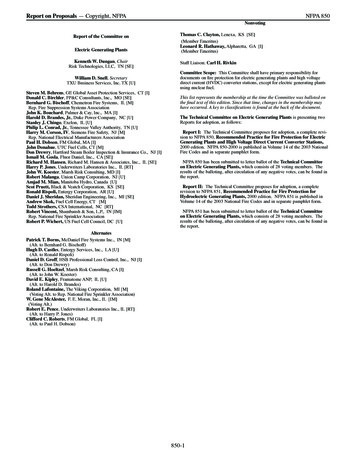
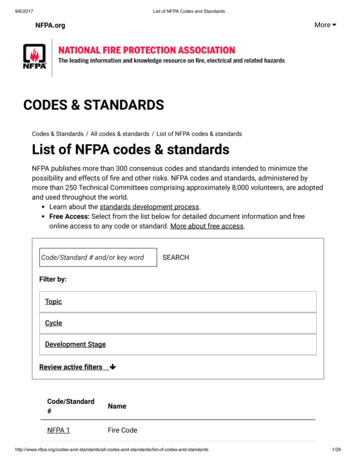
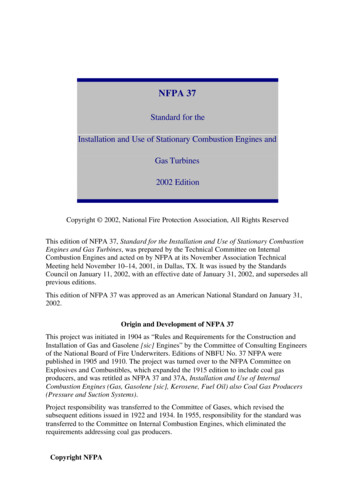
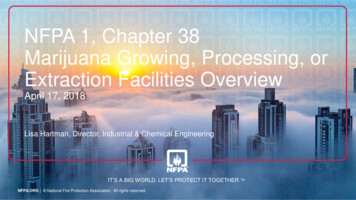
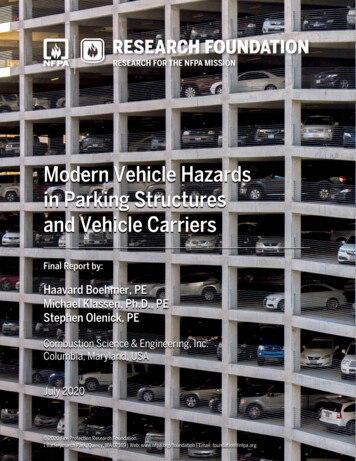
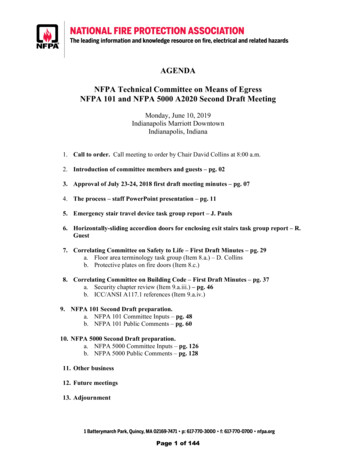
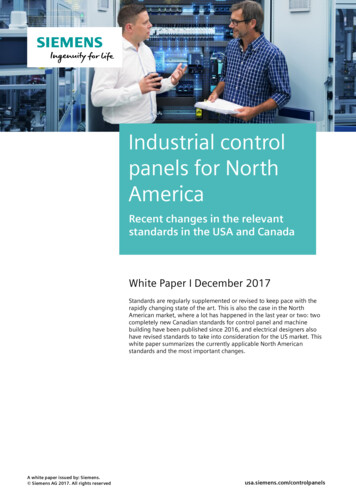
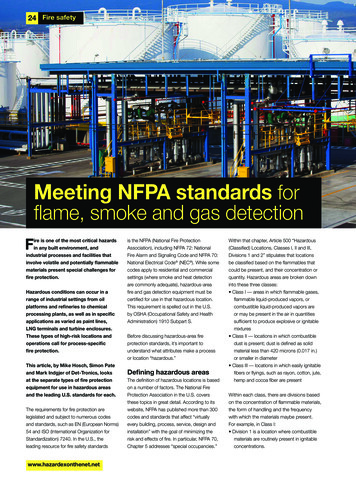
![First Revision No. 3-NFPA 497-2014 [ Chapter 2 ]](/img/5/497-a2016-eec-aaa-fd-frstatments.jpg)
